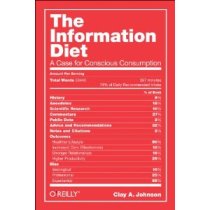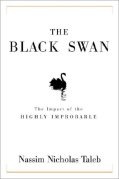My body no longer kills me when I come back from the gym. However, I had a moment of total humiliation today: theoretically my ideal body weight is 172 pounds and I weigh 153 Ibs. The woman at the gym calibrated my fat/water/meat/bone ratios, made an inward gasp and I asked her what was wrong. She said (after a tentative, you-have-cancer pause), “You’re what’s technically known as a ‘thin fat person.’ ”
– Douglas Copeland, Microserfs
We know that healthy eating – having a good, balanced diet – is the most important thing we can do for our physical health. What if the same is true of our brains? This is the simple but powerful premise that lies at the heart of Clay Johnson’s excellent book The Information Diet.
It’s also a timely thesis.
Everyone seems worried about how we consume information, about what it is doing to our brains and how it impacts society. Pessimists believe Google and social media are creating a generation of distracted idiots unable or unwilling to steep themselves in any deep knowledge. From the snide ramblings of Andrew Keen in The Cult of the Amateur to alarmed New York Times executive editor Bill Keller – who equates letting his daughter join Facebook to passing her a crystal meth pipe – the internet and the type of information it creates are apparently destroying our minds, our society and, of course, our children.
While I disagree with the likes of Keen and Keller, your humble author admits he’s an information addict. I love reading the newspaper or my favourite columnists/bloggers; I’m regularly distracted by both interesting and meaningless articles via Twitter and Facebook; and I constantly struggle to stay on top of my email inbox. I’m a knowledge worker in an information society. If anyone should be good at managing information, it should be me. Reading The Information Diet forces me to engage with my ability in a way I’ve not done before.
What makes The Information Diet compelling is that Johnson embraces the concerns we have about the world of information overload – from those raised by New York Magazine authors and celebrated pundits to the challenges we all feel on a day to day basis – and offers the best analysis to date of its causes, and what we can do about it. Indeed, rather than being a single book, The Information Diet is really three. It’s an analysis of what is happening to the media world; it’s a self-help book for information-age workers, consumers and citizens; and it’s a discussion about the implications of the media environment on our politics.
 It is in its first section that the book shines the brightest. Johnson is utterly persuasive in arguing that the forces at play in the food industry are a powerful mirror for our media environment. Today the main threat to Americans (and most others living in the developed world) is not starvation; it’s obesity. Our factory farms are so completely effective at pumping out produce that it isn’t a lack of food the kills us, it’s an overabundance of it. And more specifically, it’s the over-consumption of food that we choose to eat, but that isn’t good for us in anything greater than small quantities.
It is in its first section that the book shines the brightest. Johnson is utterly persuasive in arguing that the forces at play in the food industry are a powerful mirror for our media environment. Today the main threat to Americans (and most others living in the developed world) is not starvation; it’s obesity. Our factory farms are so completely effective at pumping out produce that it isn’t a lack of food the kills us, it’s an overabundance of it. And more specifically, it’s the over-consumption of food that we choose to eat, but that isn’t good for us in anything greater than small quantities.
With information, our problem isn’t that we consume too much – Johnson correctly points out that physically, this isn’t possible. What’s dangerous is consuming an overabundance of junk information – information that is bad for us. Today, one can choose to live strictly on a diet of ramen noodles and Mars bars. Similarly, it’s never been easier to restrict one’s information consumption to that which confirms our biases. In an effort to better serve us, everywhere we go, we can chomp on a steady diet of information that affirms and comforts rather than challenges – information devoid of knowledge or even accuracy; cheaply developed stories by “big info” content farms like Demand Media or cheaply created opinion hawked by affirmation factories like MSNBC or FOX News; even emails and tweets that provide dopamine bursts but little value. In small quantities, these information sources can be good and even enjoyable. In large quantities, they deplete our efficiency, stress us out, and can put us in reality bubbles.
And this is why I found The Information Diet simultaneously challenging, helpful and worrying.
Challenging, because reading The Information Diet caused me to think of my own diet. I like to believe I’m a healthy consumer, but reflecting on what I read, where I get my information and who I engage with, in parts of my life, I may be that dreaded thin-fat person. I look okay, but probe a little deeper and frankly, there are a few too many confirmation biases, too many common sources, leaving my brain insufficiently challenged and becoming a shade flabby. I certainly spend too much time on email, which frankly is a type of information fix that really does sap my productivity.
Helpful, because in part The Information Diet is a 21st-century guide to developing and honing critical thinking and reasoning skills. At its most basic, it’s a self-help book that provides some solid frameworks and tools for keeping these skills sharp in a world where the opportunities for distraction and confirmation bias remain real and the noise-to-signal ratio can be hard to navigate. To be clear, none of this advice is overly refined, but Johnson doesn’t pretend it is. You can’t download critical thinking skills – no matter what Fox News’s slogan implies. In this regard, the book is more than helpful – it’s empowering. Johnson, correctly I believe, argues that much like the fast food industry – which seeks to exploit our body’s love of salty, fatty food – many media companies are simply indulging our desire for affirming news and opinion. It’s not large companies that are to blame. It’s the “secret compact” (as Johnson calls it) that we make with them that makes them possible. We are what we consume. In this regard, for someone that those on the right might consider (wrongly) to be a big government liberal, The Information Diet has an strong emphasis on personal responsibility.
There is, of course, a depressing flip side to this point: one that has me thinking about the broader implications of his metaphor. In a world of abundant food, we have to develop better discipline around dieting and consumption.
But the sad fact is, many of us haven’t. Indeed, almost a majority has not.
As someone who believes in democratic discourse, I’ve always accepted that as messy as our democratic systems may be, over time good ideas – those backed by evidence and effective track records – will rise to the top. I don’t think Johnson is suggesting this is no longer true. But he is implying that in a world of abundant information, the basic ante of effective participation is going up. The skills are evolving and the discipline required is increasing. If true, where does that leave us? Are we up for the challenge? Even many of those who look informed may simply be thin fat people. Perhaps those young enough to grow up in the new media environment will automatically develop the skills Clay says we need to explicitly foster. But does this mean there is a vulnerable generation? One unable to engage critically and so particularly susceptible to the siren song of their biases?
Indeed, I wish this topic were tackled more, and initially it felt like it would be. The book starts off as a powerful polemic on how we engage in information; it is then a self-help book, and towards the end, an analysis of American politics. It all makes for fascinating reading. Clay has plenty of humour, southern charm and self-deprecating stories that the pages flow smoothly past one another. Moreover, his experience serves him well. This is man who worked at Ask Jeeves in its early days, helped create the online phenomenon of the Howard Dean campaign, and co-founded Blue State Digital – which then went on to create the software that powered Obama’s online campaign.
But while his background and personality make for compelling reading, the last section sometimes feels more disconnected from the overall thesis. There is much that is interesting and I think Clay’s concerns about the limits of transparency are sound (it is a prerequisite to success, but not a solution). Much like most people know Oreos are bad for them, they know congressmen accept huge bundles of money. Food labels haven’t made America thinner, and getting better stats on this isn’t going to magically alter Washington. Labels and transparency are important tools for those seeking to diet. Here the conversation is valuable. However, some of the arguments, such as around scalability problems of representation, feel less about information and more about why politics doesn’t work. And the chapter closes with more individual advice. This is interesting, but his first three chapters create a sense of crisis around America’s information diet. I loved his suggestions for individuals, but I’d love to hear some more structural solutions, or if he thinks the crisis is going to get worse, and how it might affect our future.
None of this detracts from the book. Quite the opposite – it left me hungry for more.
And I suspect it will do the same for anyone interested in participating as a citizen or worker in the knowledge economy. Making The Information Diet part of your information diet won’t just help you rethink how you consume information, live and work. It will make you think. As a guy who knows he should eat more broccoli but doesn’t really like the taste, it’s nice to know that broccoli for your brain can be both good for you and tasty to read. I wish I had more of it in my daily diet.
For those interested you can find The Information Diet Blog here – this has replaced his older well known blog – InfoVegan.com.
Full disclosure: I should also share that I know Clay Johnson. I’ve been involved in Code for America and he sits on the Advisory Board. With that in mind, I’ve done my best to look at his book with a critical eye, but you the reader, should be aware.






 So it is with impeccable timing that about 3 weeks ago I started listening to John Kenneth Galbraith’s “
So it is with impeccable timing that about 3 weeks ago I started listening to John Kenneth Galbraith’s “ John Kenneth Galbraith’s The Great Crash is about an emergent system – the speculatory stock market bubble that lead to the 1929 crash. Indeed what makes reading these books simultaneously so interesting is observing how Galbraith describe an emergent system without the language and frameworks available to Johnson 50 years later. Consequently, Galbraith’s book is hints at a larger system even as he struggles to describe how the decisions of hundreds of thousands of individuals could be simultaniously coorindated but not directed. He intuits a distributed system, but simple can’t describe it as accurately as Johnson.
John Kenneth Galbraith’s The Great Crash is about an emergent system – the speculatory stock market bubble that lead to the 1929 crash. Indeed what makes reading these books simultaneously so interesting is observing how Galbraith describe an emergent system without the language and frameworks available to Johnson 50 years later. Consequently, Galbraith’s book is hints at a larger system even as he struggles to describe how the decisions of hundreds of thousands of individuals could be simultaniously coorindated but not directed. He intuits a distributed system, but simple can’t describe it as accurately as Johnson.